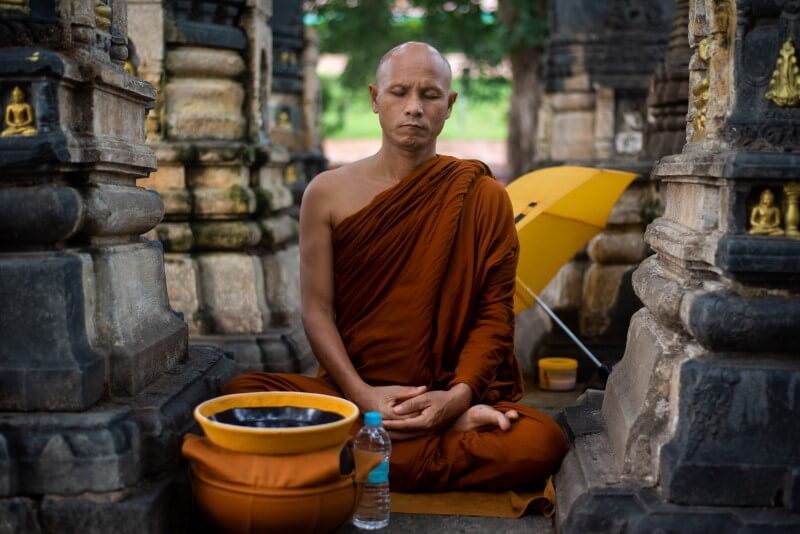A long time ago, under a big Bodhi Tree, the Blessed One decided to stay put until he felt super wise. Guess what helped him get there? Anapanasati Meditation! It’s all about paying attention to your breath. Let’s check out how to start and what it’s all about. Get ready for a simple journey into Anapanasati Meditation—where calm and wisdom meet!
What is Anapanasati Meditation?

Anapanasati, originating from the Pali language, is the art of paying close attention to our breath—delving into the nuances of how we breathe in (“ana”) and breathe out (“apana”). However, it can be seen as a simple breathing exercise.
To truly engage in Anapanasati, one must focus on the intricate sensations associated with each breath. It involves keen attention to the feeling as you inhale and exhale, the subtle movements in the chest or abdomen, and the pauses between breaths. The awareness extends to the flow of air around the nostrils, creating a comprehensive experience that goes beyond the basic act of breathing. Every sensation becomes a guide, inviting practitioners to be fully present in the rhythm of their breath, fostering mindfulness and a deeper connection to the present moment. Anapanasati, in essence, is a journey into the subtle, often overlooked aspects of the breath, transforming it into a gateway for heightened awareness and inner exploration.
Anapana: A Step towards Vipassana
Vipassana, rooted in the Pali language, translates to “insight,” symbolising a profound form of meditation that goes beyond mere breath observation. It involves a meticulous exploration of bodily sensations, aiming to foster a deep understanding of the mind-body connection and provide insights into the nature of existence.
Anapana Meditation, on the other hand, acts as a crucial precursor to the practice of Vipassana. In Anapana, practitioners start by focusing on their breath, cultivating the ability to observe and remain present in the moment. It is all about mindfulness of breathing.
This initial step serves as a foundational phase, training the mind to stay focused and fostering an awareness of bodily sensations—skills that prove invaluable when transitioning to the more advanced and nuanced practice of Vipassana. Think of Anapana as the initial journey, teaching you the art of simplicity in breath observation and laying the groundwork for a seamless progression into the deeper realms of Vipassana meditation.
Anapanasati Meditation Technique

Anapana meditation technique was first introduced by Buddha. The Buddhist literature clearly states the steps and process involved in this meditation. Below is a simplified guide on how to perform Anapanasati meditation.
A. Place of Meditation
Choosing the right environment is essential for a fruitful meditation session. Opt for a quiet, comfortable space where you won’t be disturbed, creating a sanctuary for inner reflection. The Buddha, in his wisdom, suggested three suitable places for Anapanasati Meditation: the forest, the foot of a tree, or an isolated empty place. Even a meditation hall, if calm and silent, can serve as an empty place. The key is to find a serene environment conducive to inner reflection.
B. Posture
Achieving the right posture is fundamental in Anapanasati. Consider sitting in a cross-legged or half-cross-legged position, ensuring your spine remains straight, promoting both alertness and relaxation.
C. Hand Placement and Eye Closure
Place your hands on your lap, left over right for comfort. For your eyes, you can either gently close them or keep them half-closed. Closing them shuts out distractions, turning your focus inward. Keeping them half-closed maintains a connection with your surroundings while fostering inner concentration.
D- The Eight Steps of Anapanasati Meditation
Below are the 8 steps of Anapanasati Meditation. As you start Anapanasati Meditation, you gradually move from one step to another. It takes time in mastering each step hence one needs patience and determination to follow this practice.
1. Counting (Ganana):
Description: Begin your meditation by gently counting each breath. Inhale, and as you exhale, count one; with the next breath, exhale, and count two, and so on.
Purpose: This initial step serves to establish a rhythmic pattern, creating a mental anchor that keeps your attention closely tied to the natural rhythm of your breath.
2. Following (Anubandhana):
Description: In this phase, allow your attention to follow the natural flow of your breath. Stay present with each inhalation and exhalation, letting the breath guide your focus.
Purpose: This step aims to deepen your connection to the breath, fostering an ongoing awareness of its continuous and subtle flow.
3. Contact (Phusana):
Description: Engage with the physical experience of breathing by feeling the sensation of the breath entering and leaving your body.
Purpose: By grounding yourself in the present moment through this tactile experience, you enhance mindfulness, connecting more profoundly with the act of breathing.
4. Fixing (Thapana):
Description: Concentrate your attention solely on the breath. Release external thoughts and fix your awareness on the gentle rhythm of inhalation and exhalation.
Purpose: This step is designed to develop a one-pointed focus, allowing the mind to settle and become absorbed in the calming cadence of the breath.
5. Observing (Sallakkhana):
Description: Observe your breath with heightened awareness, noting its subtleties such as the rise and fall of the chest or the sensations in the nostrils.
Purpose: Deepen mindfulness by paying close attention to these finer details, fostering a more profound and intimate connection with the breath.
6. Turning Away (Vivattana):
Description: Turn your awareness away from external distractions. Redirect your focus inward, letting go of any thoughts that may arise.
Purpose: By disengaging from external stimuli, this step helps cultivate inner stillness, allowing the mind to turn inward and become more attuned to the meditation practice.
7. Purification (Parisuddhi):
Description: Experience a sense of purification as you breathe. With each exhale, let go of any tension or stress that may be present in the mind.
Purpose: Create a mental space that is free from clutter, purifying the mind through the continuous flow of breath and promoting a serene state.
8. Retrospection (Patipassana):
Description: Reflect on your meditation journey. Acknowledge the progress made and insights gained during this introspective practice.
Purpose: This final step is geared towards developing self-awareness. By reviewing your meditation experience, you recognize growth and cultivate gratitude, marking the culmination of the meditative development.
Collectively, these eight steps form a comprehensive course of meditative development, guiding practitioners toward a state of deep inner peace and, ultimately, the attainment of Arahantship. Each step contributes to the unfolding journey, fostering a profound connection with the breath and the self.
Anapanasati Meditation: Suggestions
While many people start focusing on their breath by practising pranayama (breath control), it’s important to remember that Anapanasati meditation focuses on observing the natural breath rather than manipulating it.
Here are some suggestions for deepening your Anapanasati practice:
- Observe, don’t control: Leave pranayama techniques aside for now. Instead, become a neutral observer of your breath. Notice every sensation related to breathing, such as the air entering and leaving your nostrils, the rising and falling of your chest, and even the subtle sounds your breath makes.
- Focus on the breath, not on changing it: Don’t try to modify your breath in any way. Simply allow it to flow naturally and observe it with curiosity and detachment.
- Be patient with your mind: It’s natural for your mind to wander, especially during the early stages of your practice. This doesn’t mean you’re doing something wrong. Gently bring your attention back to your breath when you notice distractions, without judgment or frustration.
- Progress takes time: Developing a focused and clear mind takes dedication and consistent practice. Don’t get discouraged if you don’t achieve complete concentration immediately. Celebrate each small step forward and trust that your efforts will pay off.
- Embrace the flow: Meditation isn’t about achieving a specific state or outcome. It’s about being present in the moment and observing whatever arises with equanimity. Allow your thoughts and emotions to flow through you without resistance, and simply return your attention to your breath when you notice your mind wandering.
Remember, the most important aspect of any meditation practice is to be patient with yourself and enjoy the journey.
Anapanasati Meditation: Benefits

Anapanasanti Meditation is not just about benefits, it’s like a whole transformation journey. Once you become familiar with it and start doing it on a regular basis you start seeing changes in your insights. However, below are some great benefits of this breath meditation.
1. Observing Life Unfold:
Experience Life as an Observer: With Anapanasati Meditation, you become an observer of life, watching it unfold without getting tangled in chaos. Picture yourself as a peaceful onlooker, making everything seem more manageable and less overwhelming.
2. Breath Power for Emotions:
Simple Emotion Control: Meditation simplifies emotional control through your breath. If you need calmness, take slow breaths. If you need energy, breathe a bit faster. It’s a practical tool to smoothly navigate through your feelings, putting you in charge of your emotional state.
3. Increased Focus:
Exercise for Your Mind: Think of meditation as a workout for your body and mind. Regular practice makes it easier to stay focused on tasks. Envision being more efficient and fully present in everything you do—a workout that enhances your mental sharpness.
4. Increased Self Awareness:
Positive Transformations: Some may notice special signs during meditation, similar to Buddha witnessing the midday sun. But even if you don’t, the practice brings positive changes. It moulds you into a calmer, more collected version of yourself, contributing to your overall well-being.
5. One Hour, All-Day Peace:
Serenity in a Short Time: Dedicate just one hour to meditation, and it becomes the foundation for a peaceful day. It’s like having a shield of serenity, carrying that calm feeling with you, ready to face whatever comes your way. Imagine this serenity as your constant companion, helping you navigate through challenges with ease.
Anapanasati, a Buddhist Meditation is more than just a practice—it’s a journey. From being aware of the breath to following eight simple steps, it leads to a calm connection with reality. It gives you a calm mind, emotional control, and better focus, making daily life easier.
Whether you see signs or feel subtle changes, Anapanasati makes you a calmer person. Spend just one hour, and you carry that calmness throughout the day. Each breath in Anapanasati is a step toward inner peace—a journey worth taking for a harmonious life.
FAQs
Q. Is Anapanasati suitable for beginners?
Ans. Absolutely! Anapanasati is beginner-friendly and can be adapted to various experience levels.
Q. How long should each meditation session be?
Ans. Start with shorter sessions and gradually increase the duration based on your comfort level.
Q. Can I practise Anapanasati anywhere?
Ans. Ideally, choose a quiet and comfortable space, but with practice, you can adapt to different environments.
Q. What if my mind wanders during meditation?
Ans. Gently bring your focus back to the breath without judgement. It’s a natural part of the practice.
Q. How often should I practise Anapanasati?
Ans. Aim for regular practice, but the frequency can vary based on your schedule and preferences.
References
https://www.ncbi.nlm.nih.gov/pmc/articles/PMC4479888/
https://www.accesstoinsight.org/lib/authors/ariyadhamma/bl115.html

Anjani Kumar Shrivastava, a distinguished yoga expert with decades of experience, brings healing and wisdom through yoga therapy, meditation, and Ayurvedic principles. His remarkable Read more


